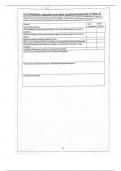Redox equations Study guides, Class notes & Summaries
Looking for the best study guides, study notes and summaries about Redox equations? On this page you'll find 259 study documents about Redox equations.
Page 3 out of 259 results
Sort by
All lesson notes for the Oxidation, reduction and redox equations topic for the AQA Chemistry course. I hope this is helpful!
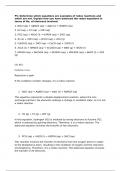
-
UNIT 13B APPLIED SCIENCE UP TO DISTINCTION
- Essay • 7 pages • 2024
-
- $10.43
- + learn more
Here are the key points I would highlight in the assignment: P4/P6 - Practical Work Measuring cell potentials for various half-cell combinations (Zn/Cu, Zn/Pb, Pb/Cu) Calculating standard cell potentials and comparing to measured values Titrations: Fe2+/MnO4-, Na2S2O3/KIO3 standardization, I2/Cu2+ determination Observations and calculations for titration volumes and concentrations Oxidation of alcohols (ethanol, ethanoic acid) with acidified K2Cr2O7 Health & Safety Proper PPE (lab ...
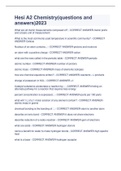
-
Hesi A2 Chemistry questions and answers 2023
- Exam (elaborations) • 8 pages • 2023
-
- $8.49
- + learn more
Hesi A2 Chemistry(questions and answers)2023 What are all metric measurements composed of? - CORRECT ANSWER-metric prefix and a basic unit of measurement What is the most commonly used temperature in scientific community? - CORRECT ANSWER-Celsius Nucleus of an atom contains... - CORRECT ANSWER-protons and neutrons an atom with a positive charge - CORRECT ANSWER-cation what are the rows called in the periodic table - CORRECT ANSWER-periods atomic number - CORRECT ANSWER-number of protons...
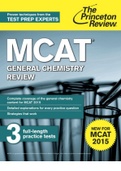
-
MCAT GENERAL CHEMISTRY CONTENTS REVIEW
- Exam (elaborations) • 540 pages • 2022
-
- $19.99
- + learn more
MCAT GENERAL CHEMISTRY CONTENTS Cover Title Page Copyright …So Much More Online! CHAPTER 1: MCAT 2015 BASICS CHAPTER 2: GENERAL CHEMISTRY STRATEGY FOR THE MCAT 2.1 Science Sections Overview 2.2 General Science Passage Types 2.3 General Science Question Types 2.4 General Chemistry on the MCAT 2.5 Passage Types as They Apply to General Chemistry 2.6 Tackling the Questions 2.7 Summary of the Approach to General Chemistry CHAPTER 3: CHEMISTRY FUNDAMENTALS 3.1 Metric Units 3.2 Densi...
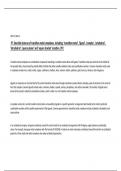
-
Unit 13C applied science- Inorganic Chemistry
- Essay • 28 pages • 2024
-
- $9.65
- + learn more
Here is a bulleted summary of the key points from the document: • Introduction to transition metal complexes - Definition of transition metals, ligands, complexes - Common coordination geometries: octahedral, tetrahedral, square planar - Square bracket notation to describe geometries • Bonding in transition metal complexes - Coordinate covalent bonding between metal and ligands - Presence of back-bonding from metal to ligand π* orbitals - Combination of covalen...
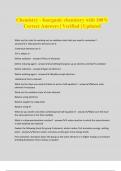
-
Chemistry - Inorganic chemistry with 100% Correct Answers | Verified | Updated
- Exam (elaborations) • 4 pages • 2024
- Available in package deal
-
- $10.49
- + learn more
Chemistry - Inorganic chemistry with 100% Correct Answers | Verified | Updated What are the rules for working out an oxidation state that you need to remember? - answer1. Monoatomic elements are 0 2.Identical elements are 0 3.H is always 1+ Define oxidation - answerloss of electrons Define reducing agent - answersomething that gives up an electron and itself is oxidized Define reduction - answergain of electrons Define oxidising agent - answer•Readily accept electrons •Substance th...
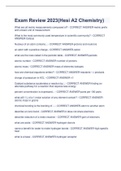
-
Exam Review 2023(Hesi A2 Chemistry)
- Exam (elaborations) • 4 pages • 2023
-
- $10.99
- + learn more
Exam Review 2023(Hesi A2 Chemistry) What are all metric measurements composed of? - CORRECT ANSWER-metric prefix and a basic unit of measurement What is the most commonly used temperature in scientific community? - CORRECT ANSWER-Celsius Nucleus of an atom contains... - CORRECT ANSWER-protons and neutrons an atom with a positive charge - CORRECT ANSWER-cation what are the rows called in the periodic table - CORRECT ANSWER-periods atomic number - CORRECT ANSWER-number of protons atomic m...
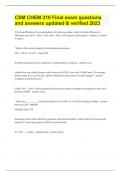
-
CSM CHEM 210 Final exam questions and answers updated & verified 2023/24
- Exam (elaborations) • 13 pages • 2023
-
Available in package deal
-
- $14.99
- + learn more
If the fuel efficiency of an automobile is 22 miles per gallon, what is its fuel efficiency in Kilometers per liter? ( 1Km= 0.621 mile, 1.00 L=1.057 quarts and 4 quarts = 1 gallon) 9.4 Km/L *What is the correct answer to the following expression: (49.1 - 42.61 ) x 13.1? 85 An intensive property of a substance is independent of amount. True Lithium has two stable isotopes with masses of 6.01512 amu and 7.01600 amu. The average atomic mass of Li is 6.941 amu. What is the p...

-
CHEM 103 MODULE 1 EXAM 2023/202
- Exam (elaborations) • 35 pages • 2023
-
- $20.99
- + learn more
CHEM 103 MODULE 1 EXAM 2023/2024 MODULE 1 EXAM Question 1 Click this link to access the Periodic Table. This may be helpful throughout the exam. 1. Convert 845.3 to exponential form and explain your answer. 2. Convert 3.21 x 10-5 to ordinary form and explain your answer. 1. Convert 845.3 = larger than 1 = positive exponent, move decimal 2 places = 8.453 x 102 2. Convert 3.21 x 10-5 = negative exponent = smaller than 1, move decimal 5 places = 0.0000321 Question 2 Click this link to...
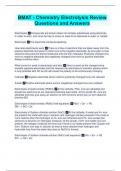
-
BMAT - Chemistry Electrolysis Review Questions and Answers
- Exam (elaborations) • 2 pages • 2024
-
Available in package deal
-
- $9.49
- + learn more
Electrolysis Compounds are broken down into simpler substances using electricity. In order to work, ions must be free to move so need to be dissolved in water or melted Electrolyte The liquid that conducts electricity How does electrolysis work There is a flow of electrons that are taken away from the positive electrode and given to other ions at the negative electrode. As ions gain or lose electrons they become atoms/molecules and are then released. Positively charged ions move to negativ...

Did you know that on average a seller on Stuvia earns $82 per month selling study resources? Hmm, hint, hint. Discover all about earning on Stuvia

